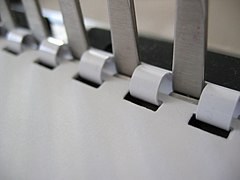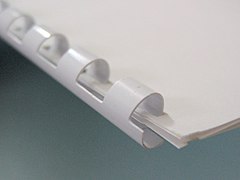Comb binding

| Inches | Millimeters | Sheets of paper |
|---|---|---|
| 3⁄16" | 4 mm | 16 |
| 1⁄4" | 6 mm | 25 |
| 5⁄16" | 8 mm | 40 |
| 3⁄8" | 10 mm | 55 |
| 7⁄16" | 11 mm | 70 |
| 1⁄2" | 12 mm | 85 |
| 9⁄16" | 14 mm | 100 |
| 5⁄8" | 16 mm | 125 |
| 3⁄4" | 20 mm | 150 |
| 7⁄8" | 22 mm | 175 |
| 1" | 25 mm | 200 |
| 1+1⁄8" | 28 mm | 250 |
| 1+1⁄4" | 32 mm | 275 |
| 1+1⁄2" | 38 mm | 325 |
| 1+3⁄4" | 45 mm | 375 |
| 2" | 51 mm | 425 |
Comb binding (sometimes referred to as "cerlox" or "surelox" binding) is one of many ways to bind pages together into a book. This method uses round plastic spines with 19 rings (for US Letter size) or 21 rings (for A4 size) and a hole puncher that makes rectangular holes. Comb binding is sometimes referred to as plastic comb binding or spiral comb binding.
Binding process
[edit]To bind a document, the user first punches holes in the paper with a specialized hole punch. Pages must be punched a few at a time with most of these machines. If hard covers are desired, they must be punched as well. In bulk applications, a paper drilling machine may be used.
Then the user chooses a spine size that will match the document. Standard sizes are 4.8 mm (3⁄16 in) (for 16 sheets of 20# paper) up to 51 mm (2 in) (for 425 sheets). Spine lengths are generally 280 mm (11 in) to match the length of letter-size paper.
The rings on the spine open and insert into the holes in the page, then rest against the body of the spine, resulting in a closure that can be opened again for making changes to the book.
-
Machine opening the spine
-
Pre-punched paper with spine rings through holes
-
Rings closed on paper
-
Completed book out of machine
Comparison with other punch binds
[edit]With this bind, the book lies flat but cannot be opened 360 degrees. For a book that can be opened such that the covers touch, a spine that does not have an obstructive body, such as a coil binding, is a better option.




